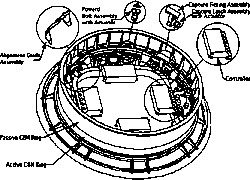
| Common
Berthing Mechanism Acceptance Test of the Japanese Experiment Module"Kibo" |
|
The Common Berthing Mechanism Acceptance
Test of the Japanese Experiment Module "Kibo" was conducted at Tobishima factory
of Mitsubishi Heavy Industry from June 27 to July 2, 2000.
 | Common
Berthing Mechanism |
 |
| Common Berthing
Mechanism
(Active CBM and Passive CBM being connected) |
The Common Berthing Mechanism (CBM) is a functional structure that is
used to connect the components of the International Space Station (except the
Russian modules).
The Japanese Experiment Module "Kibo" will use two
CBMs. One will be used to connect the Pressurized Module (PM) and the Experiment
Logistics Module's Pressurized Section (ELM-PS); the other, to connect the PM
and Node 2.
A CBM is composed of two parts, an active CBM that uses
an electric motor to make connection, and a passive CBM. To connect these two
parts, an astronaut first uses the robot arm to grapple the module on which the
passive CBM is attached and move it close to the active CBM. A limit switch located
on the active CBM senses when the passive CBM is close enough to the active CBM
and generates a signal indicating that preparation for berthing is completed.
Next, the active CBM extends four capture latches to catch the passive CBM (see
the figures).
The 16 power bolts then extend from the active CBM and
are inserted into the holes of the passive CBM, completing the connection. When
the pressurized modules are connected, a big O-ring seal made of special rubber
will seal the CBMs to maintain air-tightness inside the connected modules.
| |
| Kibo's CBM location image |
 | Test
Summary |
 |
| Active CBM | During actual
operation, Kibo's CBM will be powered by Kibo's power source, controlled by commands
generated by the Destiny's (US Experiment Module) controller. However, since the
Destiny's controller is not available for this test and bacause this is a Kibo
standalone test, we borrowed test equipment from NASA to conduct this functional
test.
The active CBM attached to the Pressurized Module (PM) was first
powered up by the test equipment power source. A control command was then sent
from that test equipment to confirm that the capture latches and the power bolts
work as they are expected.
Next we supplied power from Kibo's supply
to the active CBM in the same manner as in actual operation and sent commands
from the test equipment to the active CBM, confirming the normal operation of
the capture latches and the power bolts.
 | Future
Schedule | "Kibo" will be transported to the US, and undergo
a connectivity test using a simulated CBM ring called a CBM master tool at Kennedy
Space Center. Since all ISS modules including Kibo were designed to be operated
in microgravity, they cannot be connected to each other under gravitational conditions
on Earth.
Also, during ISS assembly mission STS-92,
in which astronaut Wakata will participate, CBMs will be used for the first time
to connect the Z1 truss and PMA-3 to the ISS (Unity).
 | Comments
from the key person |
 | This
was a cooperative test between Japan and the United States and required more preparation
than for tests conducted only by Japan. The test itself was conducted within just
a few days, however I am very much satisfied that I could finish all the procedures
including negotiations with the US. When the test facility that we borrowed from
the United States caused a problem, we questioned whether we could continue and
finish the test. However, thanks to NASA's efforts; an alternate system was transported
to Japan in two or three days. That enabled us to successfully complete the test
without much delay, and I felt relief and gratitude for their effort. Through
the preparation and the trouble recovery procedures, we could directly understand
the differences between Japanese and US cultures, both good and bad points, which
was a valuable experience for me. | Mr.Toru
Yoshihara
JEM Project Team Office of Space Utilization Systems NASDA |
|

